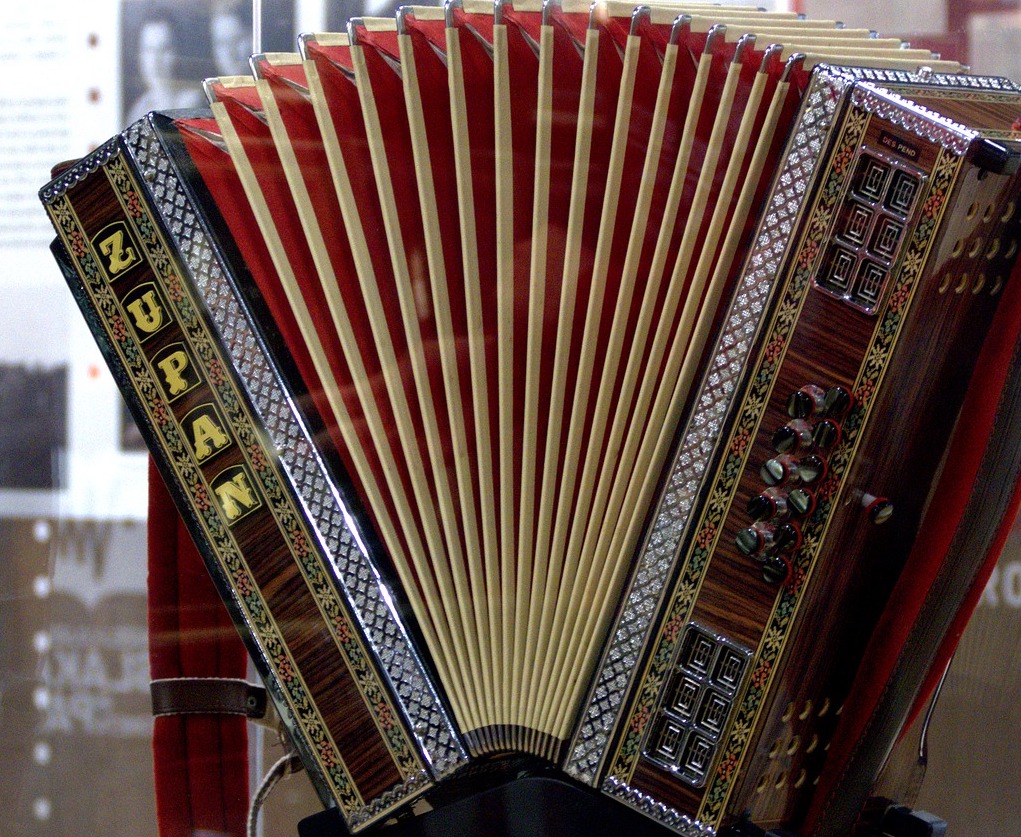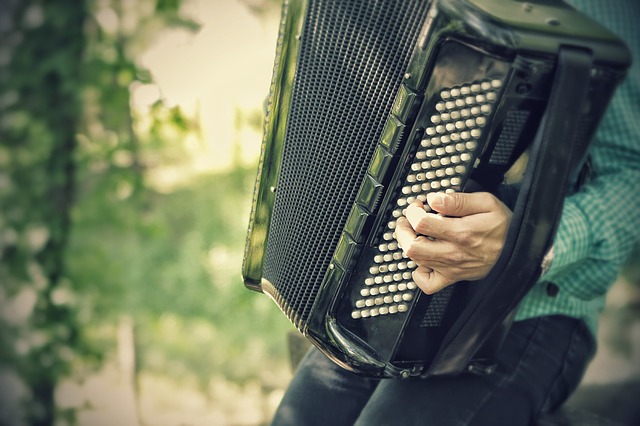Bass – The Left-Hand Side Of The Accordion
For the most part, the bass buttons on the left-hand side of the accordion are used for accompaniment. Bass buttons are aligned in a specific series or sequence.
The bellow is the middle part of the accordion, and its sole purpose is to pump air into the reeds. Without the bellows we wouldn’t have sound.
Buttons

Bass buttons are aligned in a specific series or sequence and, depending upon the size of the accordion, there can be 3, 4, 5, 6, and even 7 rows of bass buttons. Buttons are usually made of the same material as the right-hand keyboard (plastic materials), but they can also be made of more expensive materials. Directly below the bass buttons, inside the body of the accordion, we have a complex mechanism to generate sound. Since the bass has only one octave range, that means that it has only 12 valves, one for each key. However, it possesses another 12 valves with special mechanisms that allow one button to play chords consisting of three tones.
All of the bass buttons are organized by their musical function. While the two rows closest to the bellows are used for playing solo bass notes, the third row onward exhibits a special feature in that they can play chords. The first row is called the “counter bass” row, and the second row is called the “fundamental bass” row. These two rows are tuned for a one-octave range, meaning that you can play melodies, but only in a lower register. Pressing each button in the third row yields a major chord. Pressing each button in the fourth row yields a minor chord. Pressing each button in the fifth row yields a seventh chord. And pressing each button in the sixth row yields a diminished chord.
Fingering

In terms of fingering, the fundamental base row is typically played with the 4th finger; we play major row with the 3rd finger; the remaining rows we usually play with the second finger. Other fingering combinations are possible, but they depend upon the specific demands of the music. In most situations, you’ll only use fingers 2 through 5 (not counting the thumb, which is counted as finger number 1). In rare instances, the thumb can be used to play buttons in the last row. As you practice, you’ll learn to navigate the bass side of the accordion by touch, feeling for landmark buttons, such as the fundamental C (which usually has a dimple in the middle of the button) as well as the A-flat and E notes (which sometimes have hatched furrows atop the button or raised jewels).
Standard Bass System
The schemes for the fundamental bass row and the counter bass row are unique in that they are arranged in a of circle of fifths. On the fundamental bass row, beginning with the C bass button, the arrangement upward is G-D-A-E-B-F#-C#-G#-D#-A# and the arrangement downward is F-B♭-E♭-A♭-D♭-G♭-C♭-F♭(E)-A. On the counter bass row, beginning with the E bass button (which is located next to the C in the same column), the arrangement upward is B-F#-C#-G#-D#-A#-E#(F)-C-G-D and the arrangement downward is A-D-G-C-F-B♭-E♭-A♭-D♭. There is something called a “major third” distance between the fundamental bass row and the counter bass row. This means that buttons within the same column share an equal interval between them – a “major third”.
Free Bass System
An accordion that is made for classical music has a built-in system that is juxtaposed with the standard bass system; it is called a free bass system. Free bass systems alter all of the chord buttons with the help of a converter (a large mechanical register that is used for switching from one system to another). The left-hand side now becomes a melodic keyboard, much like the right-hand keyboard, and can play both deep notes and high notes.
Bellows

Even though there appears to be only one bellow in the middle of the accordion, connecting the left-hand side with the right-hand side, we actually call them “bellows.” The purpose of bellows is to pump air into the reeds. Without the bellows we wouldn’t have sound. These are the lungs of the accordion. Long ago, bellows were made of leather and raw paper. Today, they’re produced from cardboard, leather, cloth, wood, metal, and celluloid, using chemical sealing compounds. Bellows are relatively stiff, so the best way to properly open and close a bellow is to expand and contract while pressing buttons. If you want to move bellows without producing any sound, there is a special button that is specifically designed for this purpose. This air button is located on the upper left-hand side of the accordion, usually next to the bass strap. Some of the accordion do not have this button.
